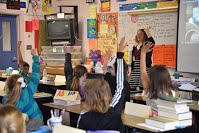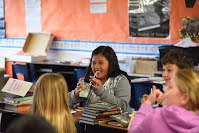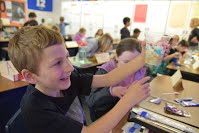Would you want to drink groundwater that has been contaminated by dog poop? Me neither. Knowing what can contaminate our water supply, and where our water comes from is important for all of us to know.
 I am serving with Washington Service Corps at RE Sources for Sustainable Communities in Bellingham, WA. I am the Green Classroom Coordinator on the Sustainable Schools team. I go into K-5th grade classrooms and give workshops on water conservation, waste prevention, and energy efficiency. I am working to protect the environment by giving elementary-aged kids the information they need to care for our planet’s resources.
I am serving with Washington Service Corps at RE Sources for Sustainable Communities in Bellingham, WA. I am the Green Classroom Coordinator on the Sustainable Schools team. I go into K-5th grade classrooms and give workshops on water conservation, waste prevention, and energy efficiency. I am working to protect the environment by giving elementary-aged kids the information they need to care for our planet’s resources.
I recently did a special program with Blaine Elementary Schools’ 4th graders. We focused on water conservation/waste prevention with an emphasis on groundwater. This program was done in collaboration with Birch Bay Water and Sewer District and The City of Blaine.
Most, if not all of Blaine’s residents get their drinking water from groundwater aquifers. Aquifers act as reservoirs for groundwater, and feed wells and springs.
 When I went into each of these classrooms and asked them where their drinking water came from, hardly any students knew. Many guessed it came from the sink. When I asked how it got to the sink, most guessed it came straight from the ocean.
When I went into each of these classrooms and asked them where their drinking water came from, hardly any students knew. Many guessed it came from the sink. When I asked how it got to the sink, most guessed it came straight from the ocean.
If we don’t know where our drinking water is coming from, how will we know how to protect it? During the workshop the students got to make their own edible aquifer. The goal was to show students the geographical layers in a groundwater aquifer, and how water — and pollution — moves through it.
Each student was supplied with a clear cup, straw, spoon, teddy grahams, fruit snack gummies, soda water and ice cream. When we got to the point of “digging our well” (the straw) the kids pumped up the “groundwater” (soda water) and got to witness how “pollution” (food coloring) moved through the aquifer and what happened to the groundwater level when it is pumped out by a well. We talked about all the different ways groundwater can become polluted: dog poop and other animal waste, pesticides, car oil, gas and heavy metals, and landfill liquid waste called, leachate.
 After this exercise, they got it. Students got a hands-on picture of how water makes it to their tap, and how easy it is for that water source to become polluted.
After this exercise, they got it. Students got a hands-on picture of how water makes it to their tap, and how easy it is for that water source to become polluted.
The students also participated in a school-wide poster contest for their Green Classrooms Action Project. The posters were hung in the cafeteria and judged by local dignitaries. The 1st, 2nd, and 3rd place winner all received an Alliance for Water Efficiency stainless steel water bottle, and the first place winner got a pizza party for their classroom!
Many students committed to changing their behavior and committing to their ACT classroom pledge. ACT stands for Aware, Conserve, and Take Action. In that classroom, 95% of students had an increase in knowledge. This was just one of seven classrooms that completed the program.
My service in AmeriCorps at RE Sources has solidified my decision to continue working with youth in environmental education. Learning sustainability and how humans affect natural resources at a young age will only benefit our broader environment in the future.
